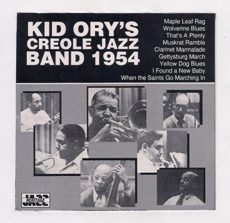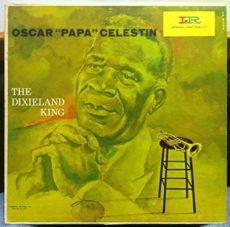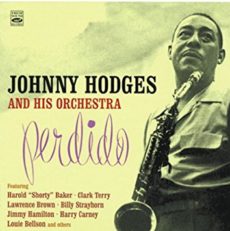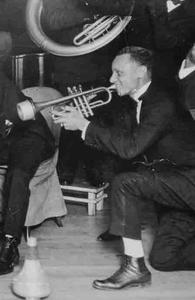
Daily Dose Of Jazz…
Edward Bertram Garland was born January 9, 1895 in New Orleans, Louisiana. By 1910 he was playing bass drum with brass bands including Frankie Duson’s Eagle Band. He then took up tuba and string bass, doubling on the two instruments which filled similar roles in different types of bands.
He played with the Excelsior Brass Band, Manuel Perez’s Imperial Orchestra and then joined other early New Orleans bands playing in Chicago, Illinois and California, such as Lawrence Duhé and Freddie Keppard. In 1916 Garland joined King Oliver and went to California and during the Depression he led his own One-Eleven Jazz Band.
1944 saw Ed gaining notoriety as a member of a traditional New Orleans band that was a leader of the West Coast revival, put together for the CBS Radio series The Orson Welles Almanac. The all-star band also included Mutt Carey, Jimmie Noone (succeeded by Barney Bigard), Kid Ory, Bud Scott, Zutty Singleton and Buster Wilson. Renamed Kid Ory’s Creole Jazz Band, the group then made a significant series of recordings on the Crescent Records label.
Garland appeared in the 1959 film Imitation of Life, performing with Andrew Blakeney, Teddy Buckner, George Orendorf and Joe Darensbourg in the funeral sequence Trouble of the World featuring Mahalia Jackson.
String bassist Ed Garland, sometimes known as Montudie Garland, a nickname he much disliked, passed away in London, England on January 22, 1980.
Sponsored By
![]()
#preserving genius
More Posts: bass

Daily Dose Of Jazz…
Oscar “Papa” Celestin was born on January 1, 1884 in Napoleonville, Louisiana to a Creole family. As a youth he worked on rural Louisiana plantations but eager for a better life, he worked as a cook for the Texas & Pacific Railroad, saved up money and bought used musical instruments. He played guitar and trombone before deciding on cornet as his main instrument. He took music lessons from Claiborne Williams, who traveled down the Bayou Lafourche from Donaldsonville.
Celestin played with the Algiers Brass Band by the early 1900s, and with various small town bands before moving to New Orleans in 1904, at age 20. There he played with the Imperial, Indiana, Henry Allen senior’s Olympia Brass Band, and Jack Carey’s dance band. Early in his career he was sometimes known as Sonny Celestin. Around 1910 he landed a job as leader of the house band at the Tuxedo Dance Hall on North Franklin St. at the edge of Storyville.
Keeping the name Tuxedo as the band’s name after the Dance Hall closed, they dressed in tuxedos and became one of the most popular bands hired for society functions, both black and white. He co-led the Tuxedo Band with trombonist William Ridgely and made their first recordings during the Okeh Records field trip to New Orleans in 1925. Following a fallout with Ridgely, the two led competing Tuxedo bands for about five years. Celestin’s Original Tuxedo Orchestra had Louis Armstrong, Bill Mathews, Octave Crosby, Christopher Goldston, Joe Oliver, Mutt Carey, Alphonse Picou and Ricard Alexis as a members over the years and made an additional series of recordings for Columbia Records through the 1920s. He also led the Tuxedo Brass Band, one of the top brass bands in the city.
Forced out of the business by depression economics, Papa worked in a shipyard until putting together another band after the World War II. The new Tuxedo Brass Band was tremendously popular and became a New Orleans tourist attraction. By 1953 he appeared in the travelogue Cinerama Holiday, became a regular feature at the Paddock Lounge on Bourbon Street and gave a command performance for President Eisenhower at the White House. He made regular radio broadcasts, television appearance, and more recordings with his last recording was singing on Marie LaVeau in 1954.
Bandleader, trumpeter, cornetist and vocalist Papa Celestin passed away in New Orleans, Louisiana on December 15, 1954, amassing 4000 people who marched in his funeral parade. The Jazz Foundation of New Orleans had a bust made and donated to the Delgado Museum in New Orleans, in honor of his contributions to the genre. #preserving genius
![]()

Daily Dose Of Jazz…
Sonny Greer was born on December 13, 1895 in Long Branch, New Jersey. He played with Elmer Snowden’s band and the Howard Theatre Orchestra in Washington, D.C. before joining Duke Ellington, whom he met in 1919. He was Ellington’s first drummer, playing with his quintet, the Washingtonians, before moving with Ellington into the Cotton Club.
As a result of his job as a designer with the Leedy Drum Company of Indiana, Greer was able to build up a huge drum kit worth over a considerable $3,000 at the time, including chimes, a gong, timpani, and vibes.
A heavy drinker and a pool-hall hustler, often needing to retrieve his drums from the pawnbroker, in 1950 Ellington responded to his drinking and occasional unreliability by taking a second drummer, Butch Ballard, with them on a tour of Scandinavia. Sonny became enraged and the subsequent argument led to their permanent estrangement.
Greer continued to play, mainly as a freelance drummer, working with musicians such as Johnny Hodges, Red Allen, J. C. Higginbotham, Tyree Glenn, and Brooks Kerr. He appeared in films, briefly led his own band and never recorded as a leader. He was part of a tribute to Ellington in 1974, which achieved great success throughout the United States.
Drummer, percussionist and vocalist Sonny Greer passed away on March 23, in 1982.
Sponsored By
![]()
More Posts: drums,percussion,vocal

Daily Dose Of Jazz…
Willie “The Lion” Smith was born William Henry Joseph Bonaparte Bertholoff Smith on November 25, 1897 in Goshen, New York. His biological father Frank Bertholoff was a light-skinned playboy who loved his liquor, girls, and gambling. His mother, Ida, threw Frank out of the house when William was two years old. After his father died, his mother married John Smith, a master mechanic from Paterson, New Jersey and Smith was added at age three.
In 1907, the family moved to Newark, New Jersey and when he was six discovered his mother’s piano in the basement and she taught him the melodies she knew. His uncle taught him to dance and subsequently he won a dance contest. It was at this time he decided to concentrate on music.
He attended the Baxter School, but after a theft incident involving a dime to see a traveling road show, he was transferred to Morton School in the sixth grade and then went on to Barringer High School, then Newark High, and attempted swimming, skating, track, basketball, sledding, cycling, and boxing to get the ladies attention. He also hung out with prizefighters like Jack Johnson, Jack Dempsey, Joe Louis, Gene Tunney and others, belong to a gang and eventually played piano in the back room of one of the members club.
Willie won an upright piano in a newspaper ad contest guessing the number of dots were in a printed circle. From that day forth, he sat down at the piano and played songs he heard in the clubs and saloons, including Scott Joplin’s Maple Leaf Rag by, Cannonball Rag by Joe Northrup, Black and White Rag by George Botsford, and Don’t Hit That Lady Dressed in Green, She’s Got Good Booty and Baby, Let Your Drawers Hang Low. By the early 1910s he was playing in New York City and Atlantic City, New Jersey.
Serving in World War I and seeing action in France, Willie played drums with the African-American regimental band led by Tim Brymn and played on the regimental basketball team. Legend has it that his nickname “The Lion” came from his reported bravery while serving as a heavy artillery gunner and he was a decorated veteran of the Buffalo Soldiers 350th Field Artillery regiment. Following the war he returned to work in Harlem clubs and at rent parties as a soloist, in bands or accompanying blues singers like Mamie Smith. Smith and his contemporaries James P. Johnson and Fats Waller developed a new, more sophisticated piano style later called “stride”.
By the 1940s his music found appreciation with a wider audience, and he toured North America and Europe up to 1971. He was at the taking of the jazz photograph A Great Day in Harlem in 1958, however, he was sitting down resting when the selected shot was taken, leaving him out of the final picture. The Lion was also an educator teaching privately and his students included such notable names as Mel Powell, Brooks Kerr, and Mike Lipskin. Although working in relative obscurity, he was a “musician’s musician”, influencing countless other musicians including Duke Ellington, George Gershwin, and Artie Shaw.
Duke Ellington demonstrated his admiration of the pianist by composing and recording the highly regarded “Portrait of the Lion” in 1939. In his later years, Newark, New Jersey honored him with Willie “The Lion” Smith Day, and Orange County, New York also proclaimed September 18th as Willie “The Lion” Smith Day, that was also the date of the first Goshen Jazz Festival.
Willie “The Lion” Smith passed away at the age of 79 on April 18, 1973 in New York City.

More Posts: piano

Daily Dose Of Jazz…
Amos White was born on November 6, 1889 in Charleston, South Carolina and grew up an orphan playing in the Jenkins Orphanage band in his teens. In addition, he traveled with minstrel shows and circuses.
After attending Benedict College, he returned to the orphanage to take a teaching position. During World War I, White played in the 816th Pioneer Infantry Band in France, then settled in New Orleans, Louisiana after the war.
Working as a typesetter, he played jazz in his spare time, working with Papa Celestin and Fate Marable among others. In the 1920s, he appeared on many records by blues singers such as Bessie Smith and Lizzie Miles, and played in the Alabamians. In 1928, he became the leader of the Georgia Minstrels.
In the 1930s, White moved to Phoenix, Arizona, where he played with his own group and with local dance groups, including Felipe Lopez’s. Later in the decade he relocated to Oakland, California, where he played locally into the 1960s in marching bands.
Trumpeter Amos White passed away on July 2, 1980 in Oakland, California.
![]()
More Posts: trumpet



